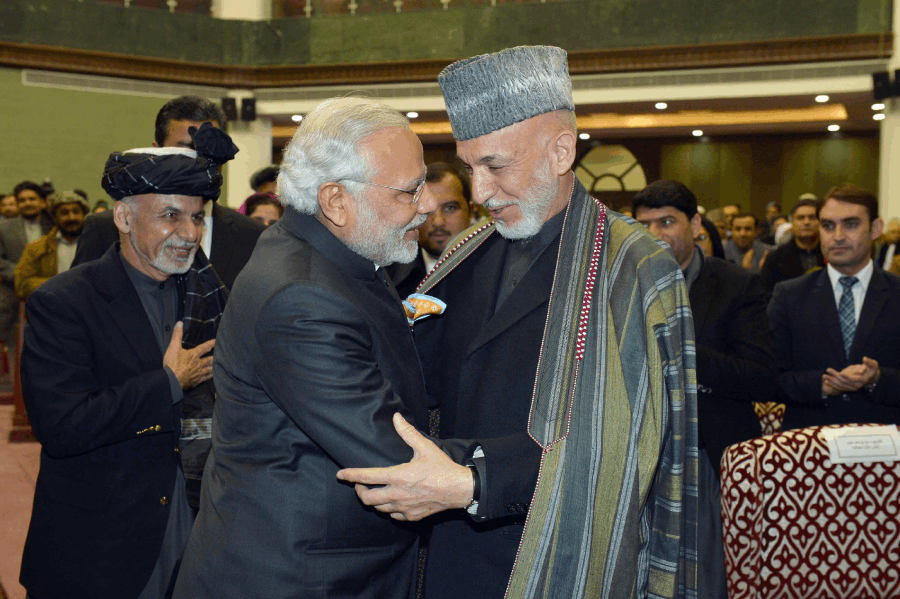India to be first to feel pinch of Taliban takeover of Afghanistan

Prime Minister Narendra Modi and President Mohammad Ashraf Ghani, at the inauguration ceremony of the Afghanistan Parliament, at Kabul, Afghanistan. (Photo: PIB)
How dramatically military and political fortunes can change within a week? And that too in a historically unstable region like Afghanistan where control over cities and even capital Kabul can change hands faster than a click on the internet. Till earlier this week, most analysts were predicting that the Afghan government, despite having its back to the wall, would be able to stave off an assault on Kabul for at least three months, thanks to the extensive and expensive training equipment to the Afghan Army, provided by the United States and its NATO allies as well as other countries, notably India.
Thus the United States, which had rapidly abandoned the government of President Ashraf Ghani and continued with a rapid drawdown of its forces from the country, was certain that the Afghan government would manage to keep the status quo which had defined political and military control of Afghanistan for the past several years, with Ghani and his supporters in control of almost all urban centres and the Taliban would stay in margins, while the US-led ‘peace talks’ that have been on for almost a decade in Qatari capital Doha would continue and a peaceful power-sharing agreement reached.
And so around July 4, when the US troops quietly slipped out, abandoning the Bagram airbase near Kabul that has served as the nerve centre of the US military operations in the the country for over two decades, even they perhaps had not imagined how quickly their protégé government would collapse in face of the Taliban, without even logistic support from the US troops.
And a month later, the White House is now openly buying protection for its Embassy and diplomatic corps in the country from the enemy that they fought and demonised for over two decades. In a clear notice that they recognize how rapidly the fortunes have changed, the US State Department on Friday told the Taliban negotiators that “they would not attack the US Embassy if they ever expected to receive international aid”.
The US and all its allies, as well as Afghanistan’s neighbours like India, and a clutch of Central Asian countries, all have been caught unprepared for the speed at which the Taliban advanced and without facing literally any resistance. Until last Saturday, less than a week ago, the Taliban controlled parts of southern Afghanistan, with some presence sprinkled around the country. The Taliban, however, were limited to rural areas, with not one of the 34 provincial capitals under their control, even though they had been gaining ground around the cities in southern and south-western parts of the country.
But in less than a week, the Taliban have overrun the country, capturing 18 of 34 provincial capitals in a matter of only five days. As the following map shows, as of August 13, there was no part of Afghanistan that was not facing high degree of threat from the Taliban, besides over half the country already under their entire control.
Washington’s Wishful Thinking
Over the past two decades, the US has modified its discourse on the Taliban as per its regional and international priorities. In 2001, after the September 11 attacks, the US declared Taliban and Afghanistan to be the hub of global terror and a threat to all peace loving nations to justify its invasion of Afghanistan.
When it rapidly displaced Taliban from power centres and literally from international visibility, it installed a government that was always going to be dependent on money and muscle provided by the Pentagon to survive. For about a decade, the US fought the Taliban with varying degrees of intensity and seriousness. However, about 10 years ago, the United States realised that the Taliban would simply not disappear and the US military presence in Afghanistan was going to be totally unlike that in mission in Libya where once they had killed Colonel Muamar Gaddafi or even in Vietnam where they pulled out when they realised that Vietcong was not going to be defeated by them. In both these cases, the risk that a withdrawal presented was limited.
But here in Afghanistan, as in Iraq, the theat of terrorist organisations taking hold of the country once the US pulled out remains not just alive or high, it is bound to happen as the Taliban have not renounced on any of their practices or policies that got the US and many other countries involved in the military disaster in the first place.
However, over the past few years, the White House has been holding talks with the Taliban and in the recent weeks, the White House as well as a number of global leaders and analysts have begun saying that a Taliban-run Afghanistan would be entirely different from the experience of 20 years ago. They go on to even say that being out of power and even out of the country for so long, some of the Taliban leaders have had exposure to liberal democracies and that the world of 2021 is radically different from 1990s and hence they hope that the Taliban would be like any other regime, even if a difficult one to deal with, but not resorting to their earlier barbaric practices or even impose the Sharia law in the country.
On part of the Western leaders, this is not just wishful thinking or naivety at its worst, these also appear to be plain, simple lies to appease their conscience and to cover their total failure in the mission to make Afghanistan a peaceful democracy that they set out for over the past 20 years, that cost USD 2 trillion and tens of thousands of Afghan and Western lives.
Trouble in backyard
Over the next few days, when Kabul falls and the Taliban take full control of Afghanistan, none of the countries that had participated in the NATO-led military operation would be immediately impacted and definitely not directly for a long while as the Taliban would first focus on putting their “house in order”. But for some nations, the theat is real and it is here. The Central Asian countries, formerly part of the Soviet Union like Uzbekistan, Turkmenistan and Tajikistan, have already begun holding military exercises on their borders with Afghanistan, with the assistance of Russia, which itself is far closer to Kabul than the Washington.
But perhaps the countries that have most to lose and most to worry about the fall of Afghanistan are India and Pakistan, albeit for entirely different reasons. Pakistan is already preparing to be again flooded by thousands if not millions of Afghan refugees fleeing the Taliban. But that is about the only worry in Islamabad, where the military – the real ruler of the country for all of its 75 years of existence – has always, including over the past two decades, kept a close hold over the Taliban and whom they have historically provided weapons, training and refuge.
For India, an Afghanistan run by Taliban will set it back by at least 20 years and that too in a regional context that is entirely different from what it was in the 1990s.
Already, the Taliban have ‘warned’ India not to have any military role in the ongoing war, putting Delhi clearly on the notice that it would soon be dealing with a government that would be far from the friendly one that has been in charge of Kabul for two decades and where India has invested over USD 3 billion in various projects and has also trained Afghan military.
Even as an unprepared Indian government scrambles to deal with the new realities of Afghanistan, it has to prepare for a far more complex situation than what prevailed in the first episode of the Taliban rule. For one Pakistan’s trouble-making capacity for India is bound to come back to the level two decades ago, when insurgency in Jammu & Kashmir was rampantly assisted or even mounted by Pakistan’s notorious intelligence services, ISI.
Pakistan is certainly aware that in many ways, now that the Americans have totally withdrawn from Afghanistan, they will look forward to Pakistan for help in ‘containing’ Taliban whatever that may mean. And Islamabad is not going to do this for charity and demand its own quota of military and monetary assistance. Moreover, this is an ideal moment for Pakistan to negotiate its relative isolation in the international community over the past decade and it is almost certain that the Western nations would not hesitate to go back to back-slapping Pakistani leaders as long as they did their bidding.
All this would be challenging for India. But a bigger challenge comes from China. Always an ally of Pakistan, Beijing has now Islamabad in an iron grip, thanks to its financial and military generosity under the Bridge and Road Initiative of President Xi Jinping. Moreover, China has already been making serious incursions across vast parts of its border with India, notably in Ladakh and Arunachal Pradesh, besides the stand-off in Doklam.
These incursions have coincided with the development of Indian alliance with the United States and New Delhi’s increasing and unprecedented willingness to be classified as a close ally of the US and to help it in ‘containing China’ and mounting the Quad presence in Indo-Pacific, which Beijing sees as its biggest threat.
Thus, now that China has a possibility to hurt India even more and specially where it hurts the most, it will not underplay its hand. China has already a significant advantage over India as its relations with the Taliban have never been adversarial and Beijing has promised dollops of Renminbis for infrastructural development.
From the few utterances and fewer actions by New Delhi over the past few weeks, it is clear that India has been caught by surprise and does not have a strategy to deal with the new regional equations.









